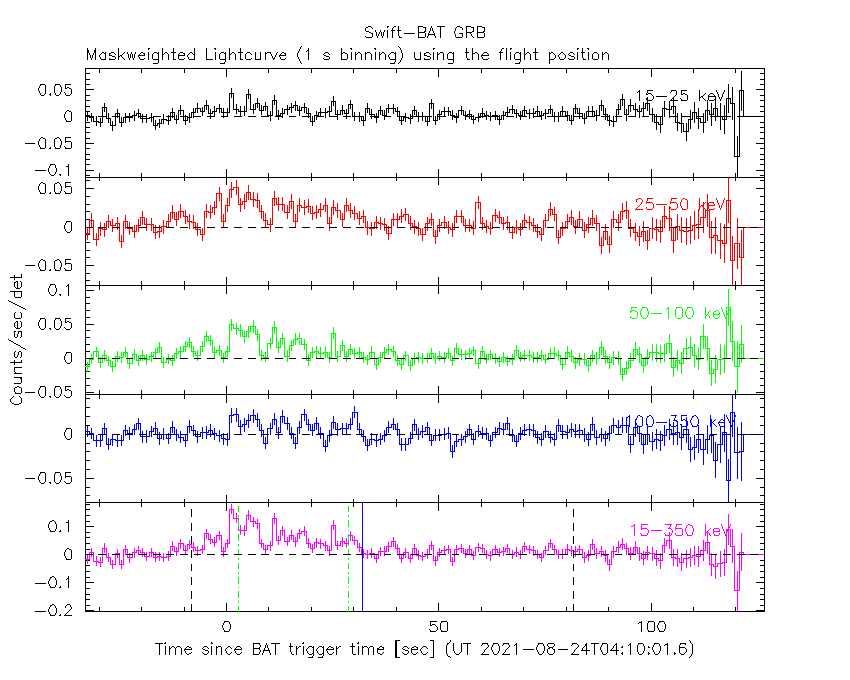
K.L. Page (U. Leicester), V. D'Elia (SSDC and INAF-OAR) and S.J. LaPorte (PSU) for the Swift team
At 04:10:01 UT, the Swift Burst Alert Telescope (BAT) triggered and located GRB 210824A (trigger=1070157) (Page et al. GCN Circ. 30700). Swift slewed immediately to the burst. At the time of the trigger, the initial BAT position was 77° from the Sun (5.3 hours East) and 123° from the 97%-illuminated Moon. Table 1 contains the best reported positions from Swift, and the latest XRT position can be viewed at http://www.swift.ac.uk/xrt_positions.
Table 2 is a summary of GCN Circulars about this GRB from observatories other than Swift.
Standard analysis products for this burst are available at https://gcn.gsfc.nasa.gov/swift_gnd_ana.html.
As reported by Markwardt et al. (GCN Circ. 30722),
the BAT ground-calculated position is RA, Dec = 232.115, 11.169 deg which is RA(J2000) = 1
The mask-weighted light curve (Figure 1) shows a single broad pulse with some sub-structure.
It begins around T-15 s, peaks at the trigger time and decays to background by T+40 s.
We note that the light curve has a gap from T+110 s to T+240 s due to the burst going out of the field of view (for a pre-planned slew that started before the trigger had been fully processed) and then coming back into FOV when the pre-planned slew ended and the automated target slew had started.
The burst appears to be over before this time.
The time-averaged spectrum from T-13.70 to T+30.94 s is best fit by a simple power-law model.
The power law index of the time-averaged spectrum is 1.18 ± 0.11.
The fluence in the 15-150 keV band is 1.7 ± 0.1 x 1
The results of the batgrbproduct analysis are available at https://gcn.gsfc.nasa.gov/notices_s/1070157/BA/.
Analysis of the initial XRT data was reported by D'Elia et al. (GCN Circ. 30704). We have analysed 19 ks of XRT data for GRB 210824A, from 291 s to 206.8 ks after the BAT trigger. The data comprise 8 s in Windowed Timing (WT) mode (taken while Swift was slewing), with the remainder in Photon Counting (PC) mode. The enhanced XRT position for this burst was given by Goad et al. (GCN Circ. 30702).
The light curve (Figure 2) can be modelled with a power-law decay with a decay index of α=0.91 ± 0.08.
A spectrum formed from the PC mode data can be fitted with an absorbed power-law with a photon spectral index of 2.3 ± 0.4. The best-fitting absorption column is 6.7 (+3.0, -2.3) x 1
A summary of the PC-mode spectrum is thus:
Total column: 6.7 (+3.0, -2.3) x 1
Galactic foreground: 3.3 x 1
Excess significance: 4.6 σ
Photon index: 2.3 ± 0.4
The results of the XRT team automatic analysis are available at http://www.swift.ac.uk/xrt_products/01070157.
The Swift/UVOT began settled observations of the field of GRB 210824A 311 s after the BAT trigger
(LaPorte and Page GCN Circ. 30730).
No optical afterglow consistent with the XRT position (Goad et al. GCN Circ. 30702) is detected in the initial UVOT exposures.
Table 3 gives preliminary
magnitudes using the UVOT photometric system
(Breeveld et al. 2011, AIP Conf. Proc., 1358, 373).
No correction has been made for the expected extinction in the Milky Way
corresponding to a reddening of

Figure 1. The BAT
mask-weighted light curve in the four individual and total
energy bands. The units are counts

Figure 2. The XRT light curve.
Any data from a crosshatched region are not included in the fit.
| RA (J2000) | Dec (J2000) | Error | Note | Reference |
|---|---|---|---|---|
| 1 |
+11°09'12.7" | 2.2" | XRT-final | UKSSDC |
| 1 |
+11°09'12.6" | 2.4" | XRT-enhanced | Goad et al. GCN Circ. 30702 |
| 1 |
+11°10'09.9" | 1.2' | BAT-refined | Markwardt et al. GCN Circ. 30722 |
| Band | Authors | GCN Circ. | Subject | Observatory | Notes |
|---|---|---|---|---|---|
| Optical | Liu et al. | 30705 | Nanshan/NEXT optical upper limit | Xinjiang Astro. Obs. | upper limits |
| Optical | Lipunov et al. | 30706 | Fermi GRB 210824A: Global MASTER-Net observations report |
MASTER | |
| Optical | Hu et al. | 30708 | BOOTES-5/JGT optical upper limit | BOOTES | upper limits |
| Optical | Lipunov et al. | 30709 | Swift GRB 210824A: Global MASTER-Net observations report |
MASTER | |
| Optical | Niwano et al. | 30718 | MITSuME Akeno optical upper limits | MITSuME Akeno | upper limits |
| Gamma-ray | Fermi | 30699 | Fermi GBM Final Real-time Localization | Fermi GBM | |
| Gamma-ray | Lesage | 30707 | Fermi GBM Observation | Fermi GBM | Fluence=5.3±0.6x1 (5 |
| Filter | Exp(s) | Mag | ||
|---|---|---|---|---|
| whit |
311 | 461 | 147 | >20.8 |
| white | 311 | 4350 | 364 | >20.9 |
| v | 467 | 4760 | 236 | >19.4 |
| b | 565 | 4145 | 235 | >20.1 |
| u | 541 | 5220 | 83 | >19.6 |
| w1 | 516 | 5170 | 236 | >20.4 |
| m2 | 4765 | 4965 | 197 | >20.3 |
| w2 | 4356 | 4555 | 197 | >19.9 |
Table 3. UVOT observations reported by LaPorte and Page (GCN Circ. 30730). The start and stop times of the exposures are given in seconds since the BAT trigger. The preliminary 3-σ upper limits are given. No correction has been made for extinction in the Milky Way.
August 28, 2021